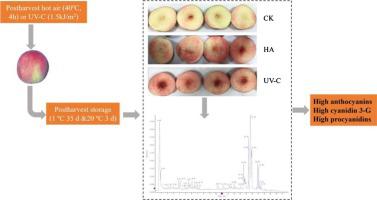当前位置:
X-MOL 学术
›
Postharvest Biol. Technol.
›
论文详情
Our official English website, www.x-mol.net, welcomes your
feedback! (Note: you will need to create a separate account there.)
Metabolic analysis of phenolic profiles reveals the enhancements of anthocyanins and procyanidins in postharvest peach as affected by hot air and ultraviolet C
Postharvest Biology and Technology ( IF 6.4 ) Pub Date : 2020-09-01 , DOI: 10.1016/j.postharvbio.2020.111227 Dandan Zhou , Qiang Liu , Jing Peng , Sicong Tu , Leiqing Pan , Kang Tu
Postharvest Biology and Technology ( IF 6.4 ) Pub Date : 2020-09-01 , DOI: 10.1016/j.postharvbio.2020.111227 Dandan Zhou , Qiang Liu , Jing Peng , Sicong Tu , Leiqing Pan , Kang Tu

|
Abstract Anthocyanins are one of the most critical components in peach fruit and are responsible for their visual appearance and nutritional value. In this study, hot air (HA) and UV-C treatments were applied to induce colour development. Peach fruit were treated with HA (40 °C, 4 h) or UV-C (1.5 kJ m−2, 20 min for each side) and then stored at 1 °C for 35 d plus another 3 d at 20 °C. The results showed that anthocyanins, procyanidins (PAs) and cyanidin-3-glucoside (Cya-3-G) increased in response to HA and UV-C during the storage period. LC–MS/MS analysis indicated that most of the individual phenols increased in response to the two treatments. However, l -phenylalanine significantly decreased. HA and UV-C significantly upregulated the enzyme activity and gene expression of phenylalanine ammonialyase to promote the conversion of phenylalanine into downstream compounds. The activities of leucoanthocyanidin reductase and anthocyanidin reductase were enhanced by HA and UV-C, which led to the accumulation of PAs. Besides, the activities of dihydroflavonol reductase, anthocyanidin synthase and UDP-glucose: flavonoid 3-o-glucosyltransferase increased in response to the two treatments, with increased contents of Cya-3-G, leucopelargonidin and pelargonidin-3-G occurring in treated fruit. In summary, HA and UV-C promoted the synthesis of anthocyanins and PAs by enhancing the activities and expressions of enzymes involved in phenylpropanoid metabolism.
中文翻译:

酚类谱的代谢分析揭示了受热空气和紫外线 C 影响的采后桃中花青素和原花青素的增强
摘要 花青素是桃果实中最重要的成分之一,决定了桃果实的外观和营养价值。在这项研究中,应用热空气 (HA) 和 UV-C 处理来诱导颜色发展。桃果实用 HA(40°C,4 小时)或 UV-C(1.5 kJ m-2,每边 20 分钟)处理,然后在 1°C 下储存 35 天,再在 20°C 下储存 3 天。结果表明,花青素、原花青素 (PAs) 和 cyanidin-3-glucoside (Cya-3-G) 在储存期间响应 HA 和 UV-C 增加。LC-MS/MS 分析表明,大多数单独的苯酚随着两种处理方法的增加而增加。然而,L-苯丙氨酸显着降低。HA和UV-C显着上调苯丙氨酸解氨酶的酶活性和基因表达,促进苯丙氨酸向下游化合物的转化。HA和UV-C增强了无色花青素还原酶和花色素还原酶的活性,导致PAs的积累。此外,二氢黄酮醇还原酶、花青素合酶和UDP-葡萄糖:黄酮类3-o-葡萄糖基转移酶的活性随着两种处理的增加而增加,处理后果实中Cya-3-G、leucopelargonidin和pelargonidin-3-G的含量增加. 总之,HA和UV-C通过增强参与苯丙烷代谢的酶的活性和表达来促进花青素和PA的合成。HA和UV-C增强了无色花青素还原酶和花色素还原酶的活性,导致PAs的积累。此外,二氢黄酮醇还原酶、花青素合酶和UDP-葡萄糖:黄酮类3-o-葡萄糖基转移酶的活性随着两种处理的增加而增加,处理后果实中Cya-3-G、leucopelargonidin和pelargonidin-3-G的含量增加. 总之,HA和UV-C通过增强参与苯丙烷代谢的酶的活性和表达来促进花青素和PA的合成。HA和UV-C增强了无色花青素还原酶和花色素还原酶的活性,导致PAs的积累。此外,二氢黄酮醇还原酶、花青素合酶和UDP-葡萄糖:黄酮类3-o-葡萄糖基转移酶的活性随着两种处理的增加而增加,处理后果实中Cya-3-G、leucopelargonidin和pelargonidin-3-G的含量增加. 总之,HA和UV-C通过增强参与苯丙烷代谢的酶的活性和表达来促进花青素和PA的合成。处理后的果实中 Cya-3-G、leucopelargonidin 和 pelargonidin-3-G 的含量增加。总之,HA和UV-C通过增强参与苯丙烷代谢的酶的活性和表达来促进花青素和PA的合成。处理后的果实中 Cya-3-G、leucopelargonidin 和 pelargonidin-3-G 的含量增加。总之,HA和UV-C通过增强参与苯丙烷代谢的酶的活性和表达来促进花青素和PA的合成。
更新日期:2020-09-01
中文翻译:

酚类谱的代谢分析揭示了受热空气和紫外线 C 影响的采后桃中花青素和原花青素的增强
摘要 花青素是桃果实中最重要的成分之一,决定了桃果实的外观和营养价值。在这项研究中,应用热空气 (HA) 和 UV-C 处理来诱导颜色发展。桃果实用 HA(40°C,4 小时)或 UV-C(1.5 kJ m-2,每边 20 分钟)处理,然后在 1°C 下储存 35 天,再在 20°C 下储存 3 天。结果表明,花青素、原花青素 (PAs) 和 cyanidin-3-glucoside (Cya-3-G) 在储存期间响应 HA 和 UV-C 增加。LC-MS/MS 分析表明,大多数单独的苯酚随着两种处理方法的增加而增加。然而,L-苯丙氨酸显着降低。HA和UV-C显着上调苯丙氨酸解氨酶的酶活性和基因表达,促进苯丙氨酸向下游化合物的转化。HA和UV-C增强了无色花青素还原酶和花色素还原酶的活性,导致PAs的积累。此外,二氢黄酮醇还原酶、花青素合酶和UDP-葡萄糖:黄酮类3-o-葡萄糖基转移酶的活性随着两种处理的增加而增加,处理后果实中Cya-3-G、leucopelargonidin和pelargonidin-3-G的含量增加. 总之,HA和UV-C通过增强参与苯丙烷代谢的酶的活性和表达来促进花青素和PA的合成。HA和UV-C增强了无色花青素还原酶和花色素还原酶的活性,导致PAs的积累。此外,二氢黄酮醇还原酶、花青素合酶和UDP-葡萄糖:黄酮类3-o-葡萄糖基转移酶的活性随着两种处理的增加而增加,处理后果实中Cya-3-G、leucopelargonidin和pelargonidin-3-G的含量增加. 总之,HA和UV-C通过增强参与苯丙烷代谢的酶的活性和表达来促进花青素和PA的合成。HA和UV-C增强了无色花青素还原酶和花色素还原酶的活性,导致PAs的积累。此外,二氢黄酮醇还原酶、花青素合酶和UDP-葡萄糖:黄酮类3-o-葡萄糖基转移酶的活性随着两种处理的增加而增加,处理后果实中Cya-3-G、leucopelargonidin和pelargonidin-3-G的含量增加. 总之,HA和UV-C通过增强参与苯丙烷代谢的酶的活性和表达来促进花青素和PA的合成。处理后的果实中 Cya-3-G、leucopelargonidin 和 pelargonidin-3-G 的含量增加。总之,HA和UV-C通过增强参与苯丙烷代谢的酶的活性和表达来促进花青素和PA的合成。处理后的果实中 Cya-3-G、leucopelargonidin 和 pelargonidin-3-G 的含量增加。总之,HA和UV-C通过增强参与苯丙烷代谢的酶的活性和表达来促进花青素和PA的合成。











































 京公网安备 11010802027423号
京公网安备 11010802027423号